

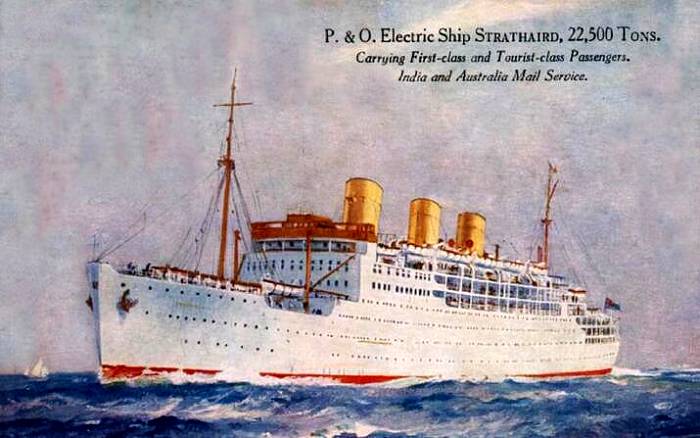
Gross Registered Tonnage
22,540 tons
Length x Width 664 feet x 80 feet
Builder and Year of Build Vickers-Armstrongs of Barrow - 1931
First Class + Tourist Accommodation 498 + 670 persons : Total 1,168
passengers
Sister-Vessel S.S. Strathnaver
Subsequent Names None
Ultimate Fate Broken up at Hong Kong in 1961
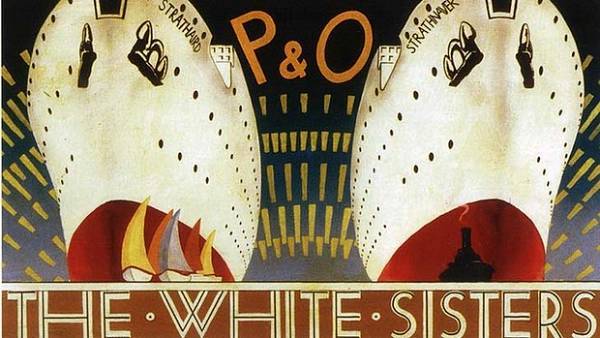
Early in 1930, the Peninsular and Oriental Steam Navigation Company ordered
the two "White Sisters"
Strathnaver
and
Strathaird.
These two ships differed from anything seen before from P&O; they set the
style and standards for all the future P&O mail steamers right up to the Canberra
in 1961. At 22,540grt, they were the largest ships to be built for the
company at that time.
On
23rd April, 1930,
at the Barrow-in-Furness yards of Vickers Armstrong Ltd,
Strathaird's
keel was
laid, and designated yard number 664. She was launched
on the 18th July, 1931, by Lady Margaret Shaw, the daughter of P&O's
chairman, Lord Inchcape, and the wife of Mr Alexander Shaw who was to be the
next Chairman of the company.
Strathaird's name was
derived from the title of Sir William Mackinnon, the founder of the British
India Company, and was the name of a headland on the Island of Skye.
Strathaird was
handed over to P&O on 10th January, 1932, the second of
the five sister ships of the 'Strath Class'.
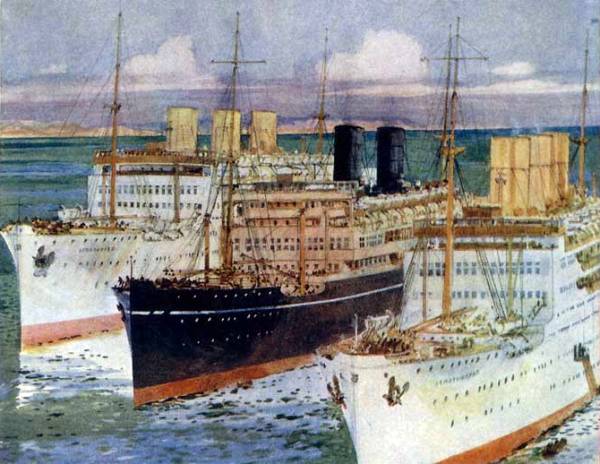
Prior to Strathnaver and
Strathaird, all P&O's steamships had black-painted hulls and
funnels. With their splendid new livery of white hulls and
buff funnels, the new ships earned many sobriquets, including: The White Sisters,
The Strath Sisters, and so on.
It
was extremely successful for the company's ships as they spent a great deal
of time voyaging in tropical waters. In addition, this was only the second
time that P&O had given its ships three funnels - the first being
Naldera
and
Narkunda
in 1918 and 1920. British public opinion in the early 1930s, tended to judge
the power and safety of a ship by the number of its funnels. Entering
Company service during the
Great Depression, there is no doubt that the introduction of The White
Sisters, lifted the spirits of
a nation worn down by economic misery.
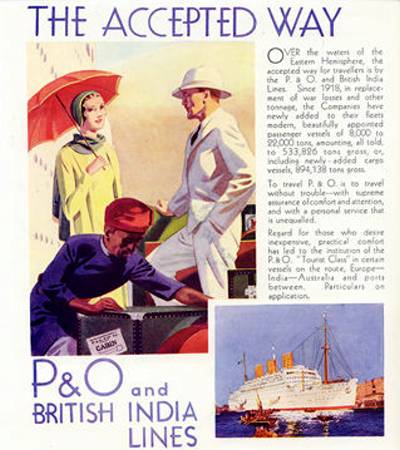
The P&O board were justifiably
proud of their fine new liners and advertised their luxury, style and speed
at every opportunity. As to the interior
decor, they boasted:
"While any tendency to elaboration or ornateness has been obviated, the
styles of decoration and furnishing are always pleasing and effective...."
Strathaird and Strathnaver
bore all the characteristics of sister ships. Each had four water-tube
boilers and two auxiliary boilers. Following the success of the Company's
first large turbo-electric liner, the Viceroy of India, the Company selected
the same innovative propulsion system for Strathnaver and Strathaird,
giving them some three knots over their illustrious predecessor.
In the early 1930s they were
the largest British-built turbo electric ships. The boilers had a combined heating
surface of 56,000 square feet (5,203 m2) and supplied steam at 425 lbf/in2
to two turbo generators. These supplied current to two electric motors with
a combined rating of 6,315 NHP or 28,000 shp. British Thomson-Houston of
Rugby, Warwickshire built the turbo-generators and motors. The motors drove a
pair of inward-rotating screw propellers.
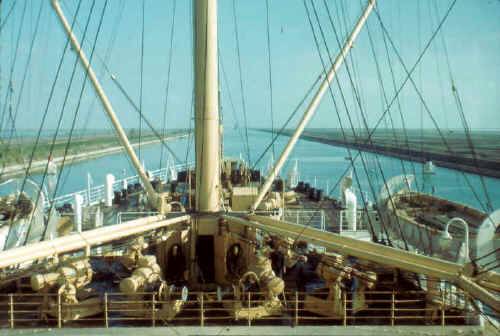
Strathaird in the Suez
Canal
Strathaird left Tilbury on her maiden voyage on 12 February 1932,
calling at
Port Said, Aden, Bombay,
Colombo, Fremantle, Adelaide, Melbourne and Sydney. She would later take her
share of cruise duties, with many of her country men and women enjoying
their introduction to cruising aboard her, especially in the tourist class.
It was whilst
Strathaird was on a
Mediterranean cruise, at 5.50am on 19th June, 1936, that she travelled along
the central line of a total eclipse of the sun, while she was cruising
between Corfu and Athens and
off the island of Hydra.
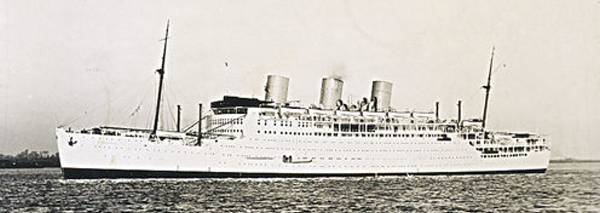
Strathaird and Strathnaver were each equipped with
DF - direction finding
equipment, an echo sounder and a gyrocompass As built, Strathaird had
accommodation for 498 first class and 670 tourist class passengers.
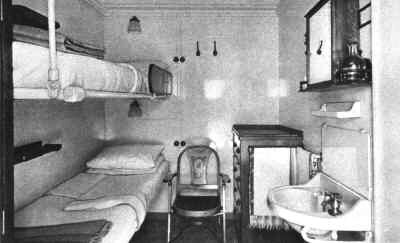
Two-berth, tourist
class cabin
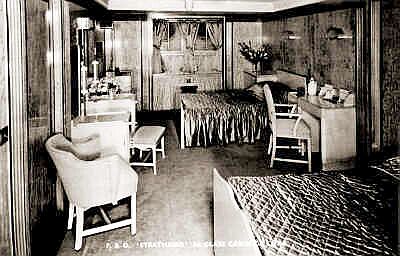
First class,
two-berth suite
With her well
appointed public rooms, her decor was very much of the period, modern and
contemporary, and admired by both first and tourist class passengers. P&O
was keen to reflect its national identity in the interior designs of its
ships, and it is acknowledged that Strathnaver and Strathaird were the first
ships to incorporate and exploit this sense of national pride. The interior
design of the ships displayed themes of art deco and period style, a look
which had become a P&O house style since the Viceroy of India, and were the
overall responsibility of the chairman's wife, Lady Inchcape, and her
daughter, Lady Margaret Shaw. The first class writing room of
Strathaird was gently Queen Anne in styling, complete with decorative
plasterwork on the ceiling, English cedar panelling, walnut furniture and
Turkish rugs. To enhance the effect, natural light was filtered by means of
leaded windows, decorated with stained glass.
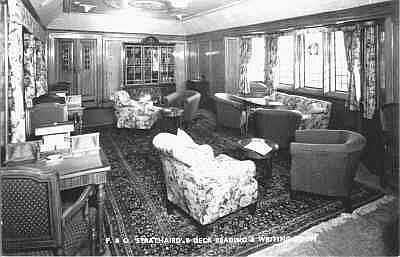
Strathnaver and
Strathaird brought new
standards of luxury to the Australian service. There were eight passenger
decks, from 'A' deck down to 'H' deck. 'A' deck, which was also the boat
deck, was exclusively the first class sun and sports deck.
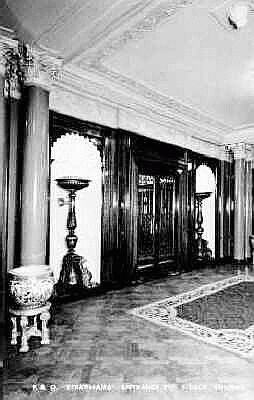
'B' deck was again exclusively
first class; here could be found the public rooms for that class. Right
forward on this deck was the main lounge, with a veranda lounge on either
side.
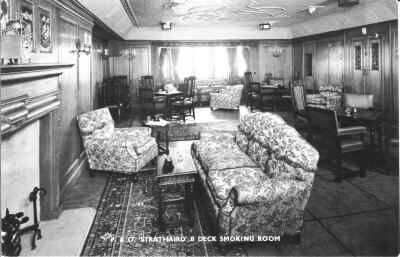
Aft of this was the smoking room
and next to this, on the starboard side, the reading and writing room. Then
came the dancing space and, aft of that, two corridor lounges and the
veranda cafe.
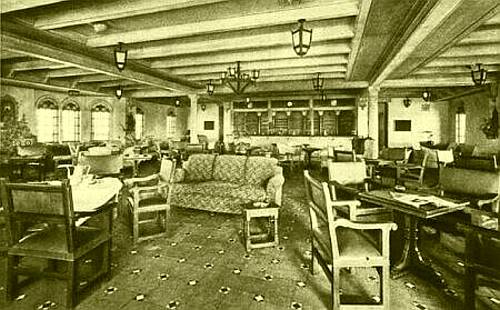
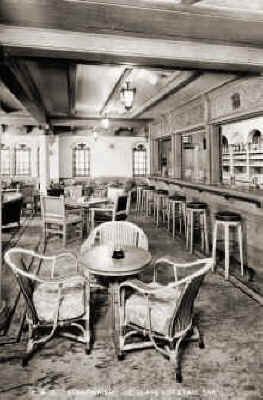
Right aft on this deck was the
children's nursery and playground area.
'C' deck was again exclusively first class, mainly taken up with cabins,
many of these being single berth.
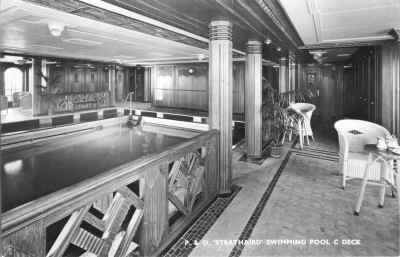
Right aft was the swimming pool.
'D' deck forward was an open deck for the first class and amidships were
first class cabins, which included six staterooms.

Further aft this deck opened out to
the tourist sports and sun deck, with the veranda cafe and swimming pool.
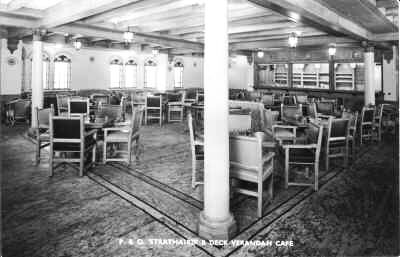
Right aft were the passengers'
hospitals. On 'E' deck, amidships, were first class cabins, again many of
them being single berth. Further aft was the tourist class dance space,
lounge, children's nursery and playground.
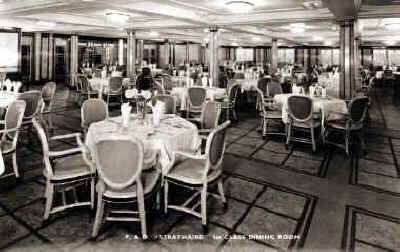
The dining saloons for both classes
were on 'F' deck, the first class saloon amidships and the tourist class aft
of it, with the galley situated between them. Forward of the first class
saloon were more first class cabins and aft of the tourist class saloon was
the tourist smoking room. Right aft on this deck was the laundry. Passenger
accommodation on 'G' and 'H' decks was aft and consisted of tourist class
cabins.
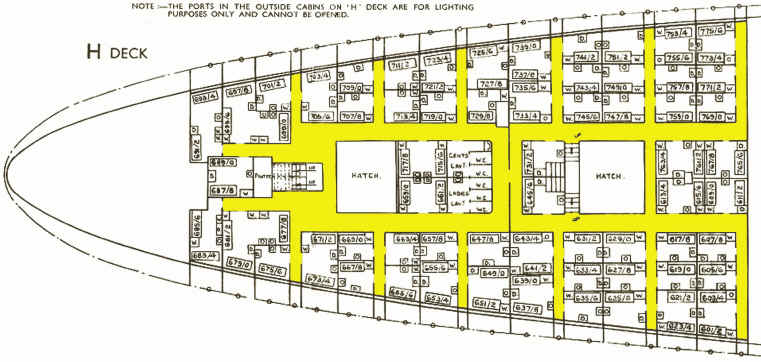
Please Note: I hold
copies of all Strathaird's deck plans - please email me if you require them.
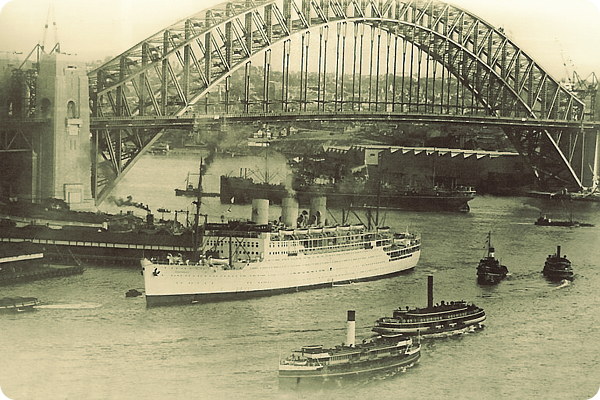
Strathaird
arriving Sydney, December 1932
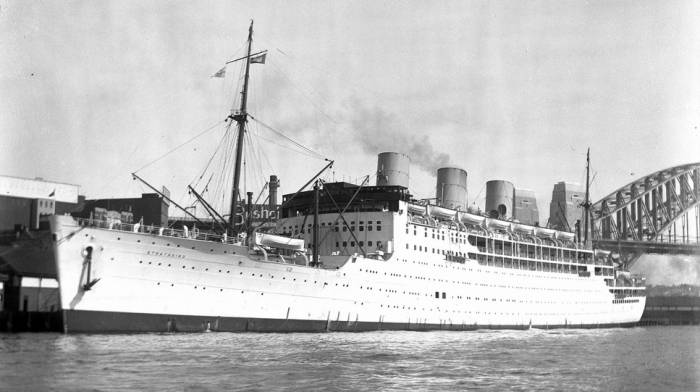
Strathaird
alongside Circular Quay, Sydney
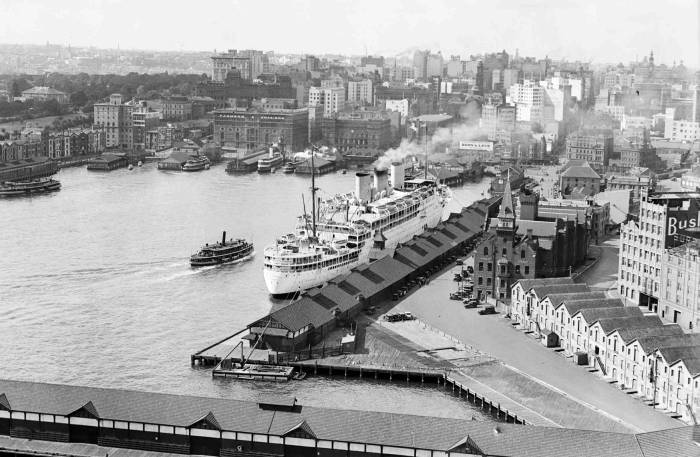
West
Circular Quay, Sydney. Photo: Sydney Morning herald
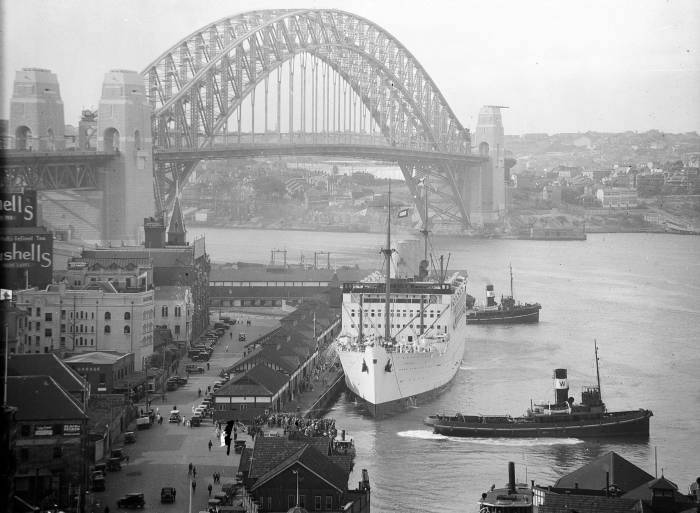
Tugs fast,
fore and aft. Photo: Sydney Morning Herald
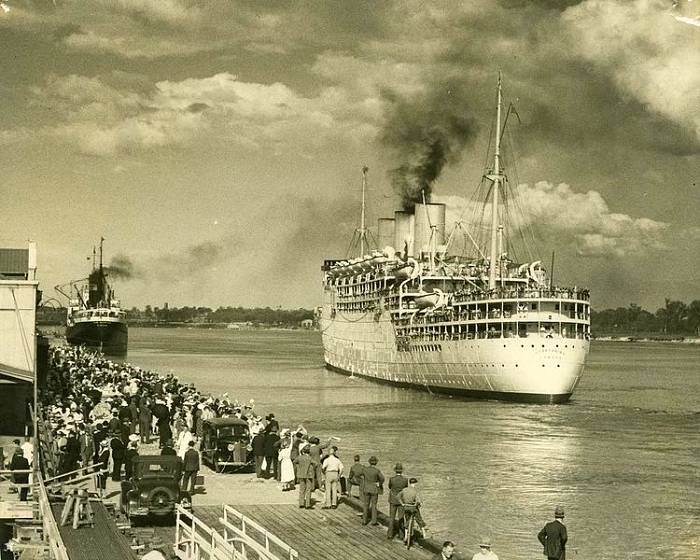
Strathaird departure Port Hamilton, Brisbane. Photo:
Queensland State Library
P
& O became the first major world shipping company to operate cruises out of
Australia and on Friday
December 23, 1932, with 1,100 passengers embarked, Strathaird became the very first large liner to
operate a cruise as she slipped past Sydney Heads, and headed for Norfolk Island on a five day Christmas cruise.
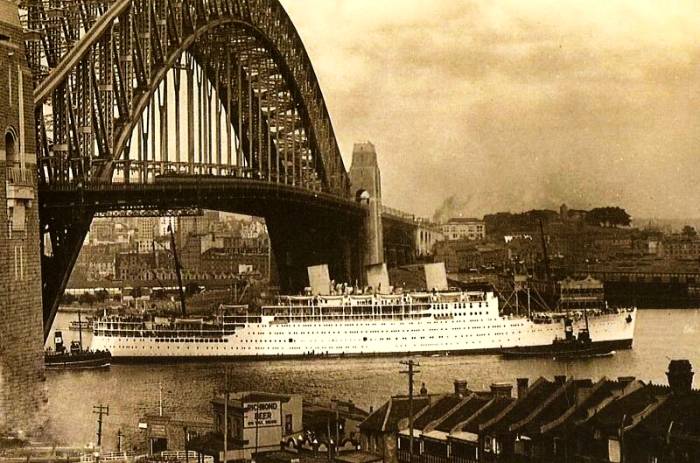
Departing Sydney on P&O's inaugural Australian cruise, Friday
December 23, 1932.
"As she inched
slowly away from the berth, the departure of P&O's new gleaming-white ship, RMS
Strathaird, heralded the beginning of a new era, though few of the hundreds of
people lining the ship's rails or waving from the shore realised the magnitude
of the occasion. Strathaird was sailing away for a five-night cruise with just
two ports of call - Brisbane and Norfolk Island. It was the beginning of P&O
Cruises' first cruise from Australia and was one of the world's first cruises.
"It
was 23rd December, 1932 and the
Harbour Bridge had only just opened as they boarded the P&O liner, RMS
Strathaird at Circular Quay. Mrs Taylor, then of Newtown, spent five nights on
the cruise, during which she remembers lunching with the administrator of
Norfolk Island. She wore a white evening dress to Christmas dinner on board the
ship where they ate turkey and pudding and danced through much of the night.
There was no alcohol consumed by the young women and they spent most of the time
playing games." Source: Sydney Morning Herald
One of the
highlights of the cruise was a Pyjama Parade, seen below.....
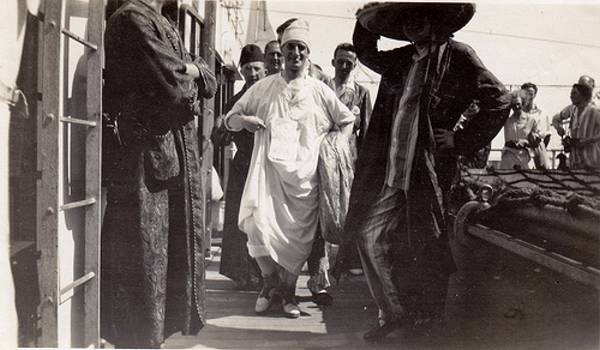
Gentlemen passengers, clad
in their night attire, formed a human 'snake', that wended its way right around
the ship...
Two of the
passengers on that first cruise were Isobel Bennett a distinguished marine
zoologist, and her sister, Jean. "Christmas Day at sea was just fantastic," she
recalls. "There was much celebrating, beginning with a carol service and the
highlight was dinner with all the trimmings. Tables were laden with food, the
boar's head, the pheasants - it was superb. We had lots of activities during the
cruise including deck games, fancy dress ball, dancing every night." Miss
Bennett clearly remembers the call at Norfolk Island. "The splendid Norfolk
Island Pines were still there - later to be cut down for the building of the
airstrip. It was a big occasion for the island - they had never before been
visited by such a big ship," she says. "Strathaird stood off the port and we
were ferried ashore by the ship's lifeboats. We visited the little church built
by the Melanesian missionaries, which is still one of the island's attractions."
In March 2010, the
island's authorities created a stamp in honour of Strathaird's 1932 visit.
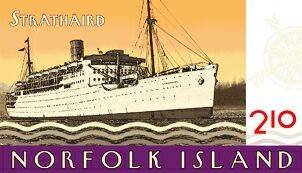
The main attraction of cruising in
the 1930s was the experience of being on a big ship. In those days, the only way
to enjoy an experience of this kind was to travel from Australia to overseas
ports, usually to England via the Suez Canal. As Australia's coastline was
serviced by smaller ships, unless they had done the 'big trip overseas', many
Australians had never been on an ocean liner before. P&O were to change all that
on 23rd December 1932. Strathaird's Christmas cruise was the exciting beginning
of a new type of holiday experience for Australians. Incredibly, the ship was
fully booked three days after the cruise was advertised. Encouraged by this
eager and positive response, P&O developed a program of cruising holidays
throughout the 1930s, to cater to the growing cruising market in Australia,
which still exists to this day.
Sir
Robert Gordon Menzies ~ Australia's longest serving
Prime Minister
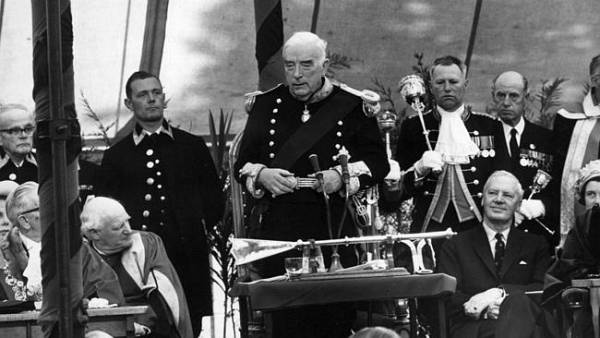
Photo:
News Limited
Robert Menzies was forty before he
visited England for the first time in 1934, five years before the commencement
of his first term as Australia's Prime Minister. He went as a member of the
Australian delegation attending King George V's Silver Jubilee. Sailing in the
Strathaird, past the coast of Africa and through Aden on its fourth voyage to
England from Australia, he wrote in his diary: "Further reflections on the
persistent Englishness of the English: Here is a golf course, there is a soccer
football ground... The more I see of such people, the more satisfied I am that
while doctrinaires and theorists speculate about self-government for natives,
the British calmly go on their way giving to these people what obviously they
could never give to themselves". And when the Strathaird reached its
destination: "At last we are in England, our journey to Mecca has ended, and our
minds abandoned to those reflections which can so strangely (unless you remember
our traditions and upbringing) move the souls of those who go 'home' to the land
they have never seen." On arriving, he revelled in the sights and sounds of the
centre of Empire and the peace and harmony of the English countryside,
discovering the places he began reading about as a schoolboy in Jeparit,
on the Wimmera River in Western Victoria.
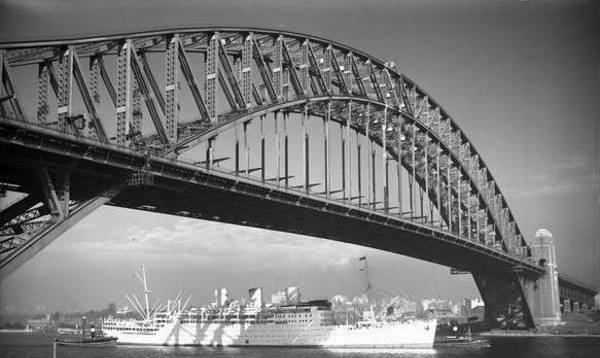
Strathaird,
sun-dappled in her heyday, passing under the Sydney Harbour Bridge.
Strathaird's 1939-45
War Service
On the outbreak of the Second World War, whilst the
smaller P&O liners were requisitioned for service as armed merchant cruisers,
the size and speed of
Strathnaver
and Strathaird
suited them for conversion to troopships. Both ships were taken over by the
Ministry of War Transport and were refitted and converted for their new role in
Liverpool. Their cabin furniture and bulkheads were taken out and replaced with messdecks,
hammocks and mess tables, while their hulls and superstructures were repainted
in drab wartime grey.
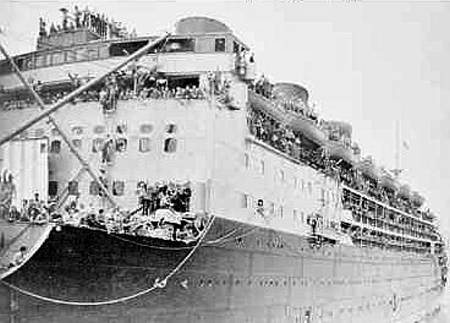
Departing
Wellington on 5th January 1940, repainted in drab wartime grey.
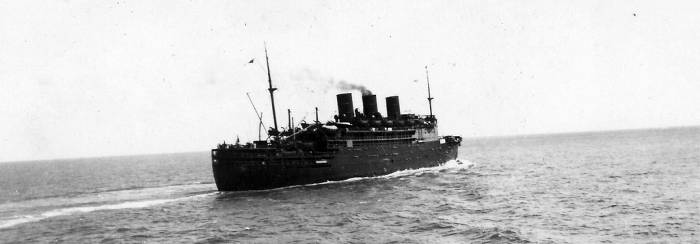
Strathaird
in the Mediterranean, en route to Alexandria, with soldiers of
the Australian Infantry Brigade embarked.
In June, 1940,
Strathaird
was still being refitted at Liverpool when she was
called away and ordered to Brest. When she arrived there, only days before the
fall of France, she embarked 6,000 troops and hundreds of civilians, including
200 children. She also took on the gold from British banks in Paris. All of her
passengers were landed safely in Plymouth on 18th June.
Strathaird was primarily used
for trooping duties to Africa and the Middle East. In 1942 she brought US forces
across the Atlantic, before being involved in trooping to India from 1942 to
1945. In November 1942, she took part in the Allied landings in North Africa.
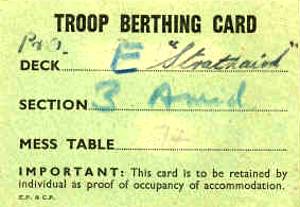
After the war in Europe had ended,
Strathaird
was employed repatriating New Zealand Forces back to their homeland. During the
war she had steamed 387,745 miles and carried 128,961 personnel. Late in 1946,
she went back to the Vickers Armstrong's yard at Barrow, where she was
reconditioned ready to resume her civilian service.
During refit, her two dummy funnels
were removed, which modernised the appearance of the ship and provided her
passengers with more open deck space on 'A' deck.
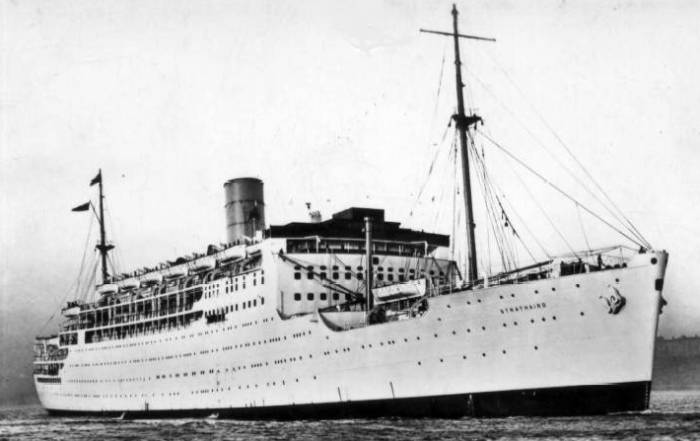
Strathaird
was the first of the two White Sisters to resume the Australia service in
January, 1948. When she left Sydney on 10th March 1948, under the command of
Captain H. S. Allan, RD, RNR, it was her first post-war return voyage.
She carried with her as
passengers the Australian Test Cricket team under their Captain, Don Bradman.
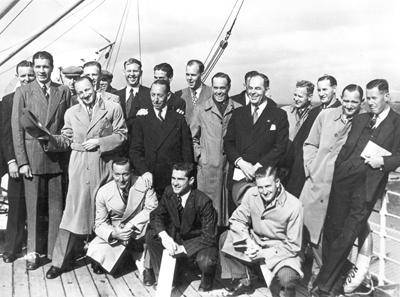
The 1948 Australian Test Team on the
deck of Strathaird after their arrival at Tilbury in April 1948. Bradman is in a jocular mood 'tipping his lid'.
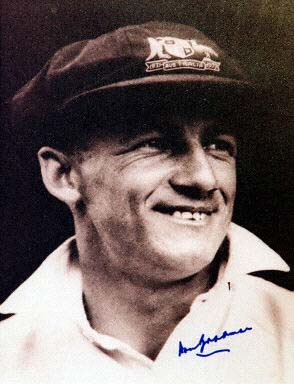
Don Bradman, the Australian
cricket captain.
The team arrived in Tilbury on
16th April, 1948 to start the 1948 England-v-Australia test series. They
won the Ashes 4–0, completed the tour unbeaten, and entered the history
books as 'The
Invincibles'. Bradman was
40 years of age - remarkable for a first class cricketer.
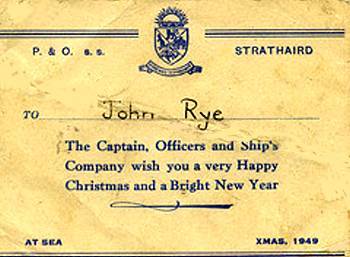
In May 1950, the Strathaird was
involved in a collision with the Isthmian Lines 4,705 tonne freighter, Steel Age
near Tilbury. Strathaird sustained minor damage. The freighter received damage
to plates, frames, brackets and beams, which cost $US 6,122.00 to repair.
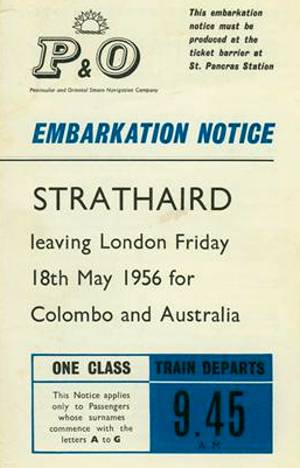

Strathaird
at Melbourne in the late 1950s
With the arrival of Arcadia and Iberia in 1954,
Strathnaver
and
Strathaird were converted to
'one class tourist ships', carrying 1,200 passengers. Their conversion coincided
with the withdrawal from service and breaking up of
the beautiful sister-ships Mooltan
and
Maloja of 1923 vintage, which
had been employed as tourist class ships - mainly carrying migrants from the UK
to Australia.
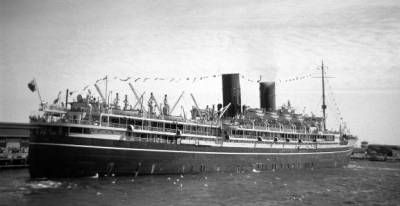
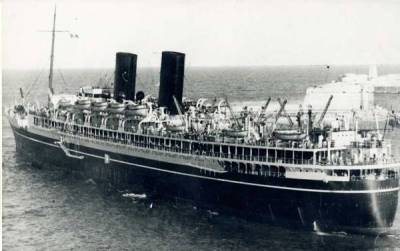
The End of Days....
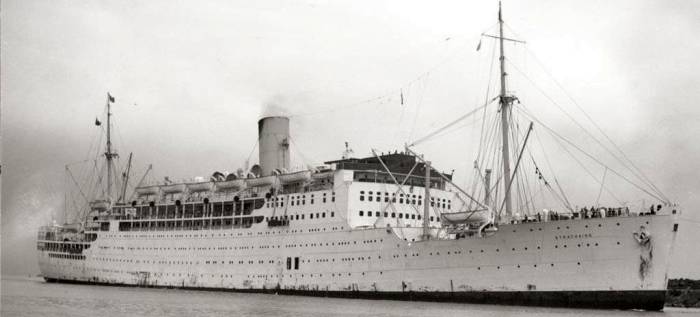
On 15th February, 1958
Strathaird
made an unexpected call at Djakarta during a voyage home from Australia to
evacuate Dutch nationals. The passengers were moved into the forward
accommodation and the refugees were accommodated aft. She disembarked them at
Rotterdam on 13th March and arrived at Tilbury on the 14th, just one day late.
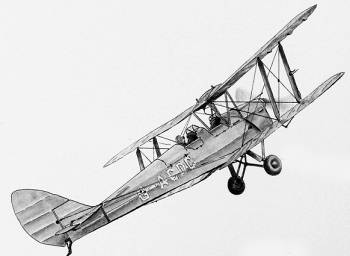
On 24th June 1959, shortly after leaving Singapore,
Strathaird was involved in the
dramatic rescue of two airmen from a Tiger Moth plane, which had crashed into
the sea. Her Commander, Captain Lethbridge, immediately turned the ship around
and as they approached, they spotted two figures sitting on the fuselage. Both
accident boats were lowered and
the airmen were rescued - as their aircraft sank beneath them.
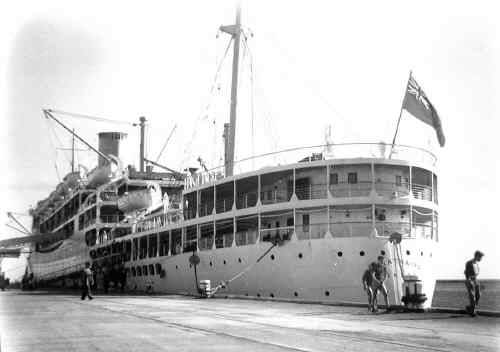
Strathaird berthed at
Adelaide in the outer harbour.
"P&O-Orient Lines announce that the
22,500grt passenger liner
Strathaird
is to be withdrawn from service when she arrives in London on 18th June, 1961.
Since March, 1954,
Strathaird
has operated as a one class vessel."
P&O Press release,dated
24th March, 1961
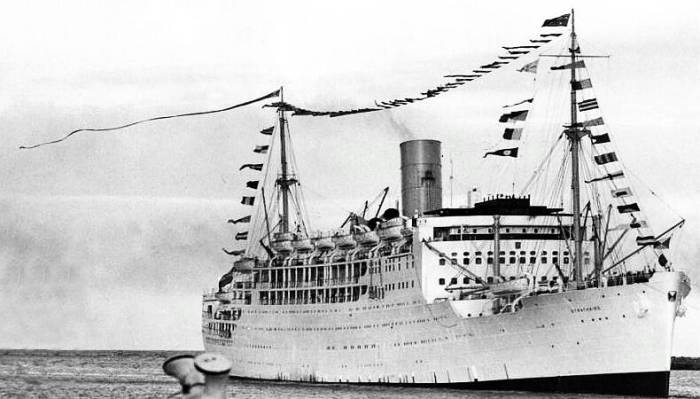
Leaving Fremantle for the
last time, with her 'paying-off pennant' streaming
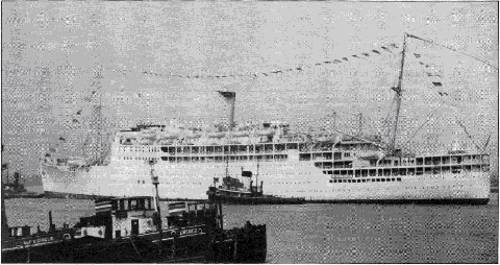
Strathaird arrives at
Tilbury for the last time.
She was given a terrific send-off from each of the Australian ports, where she
had become such a familiar sight.
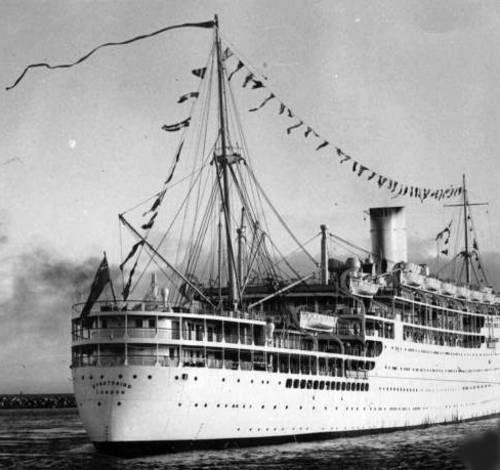
The Perth Daily News of 19th May 1961, recalled that
she had been one of the first ships to pass under Sydney Harbour Bridge, while the
Adelaide News recalled her first visit in March 1932. In
Sydney there was a farewell lunch on board for 150 invited guests.
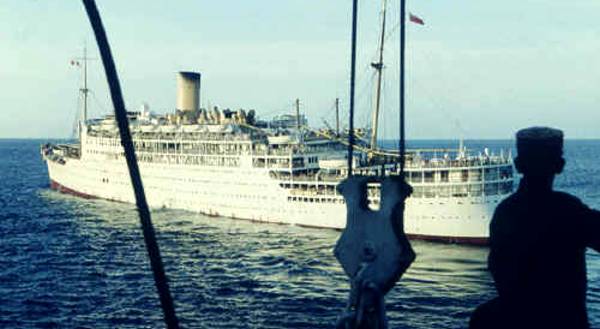
Her withdrawal from service coincided with the introduction of the
Company's latest ship,
the ss
Canberra, and on 8th June, 1961, a
dramatic meeting took place in the Mediterranean, near Port Said.
The brand new 45,000grt
Canberra
was on her maiden voyage, outward bound for Australia and New Zealand, with
2,238 passengers embarked, while
Strathaird was homeward
bound for the very last time. Ship's whistles sounded as the two ships passed,
and Captain A. E. Clay, OBE, commanding
Strathaird, sent the following
signal to Commodore Geoffrey Wild, in command of
Canberra, "You look magnificent
and all in
Strathaird wish you a happy and
successful voyage, and from the old to the new,
Strathaird bids you farewell."
Commodore Wild replied "You too look magnificent with your paying off pennant
flying gaily. You look a gracious and not too elderly lady. All well here."
All was not well, however, as
Canberra was experiencing engine room teething problems: one of the condensers
was leeching saline into the distilled water, probably caused by leaky piping.
The problem caused her to miss her
southbound convoy at Port Said.
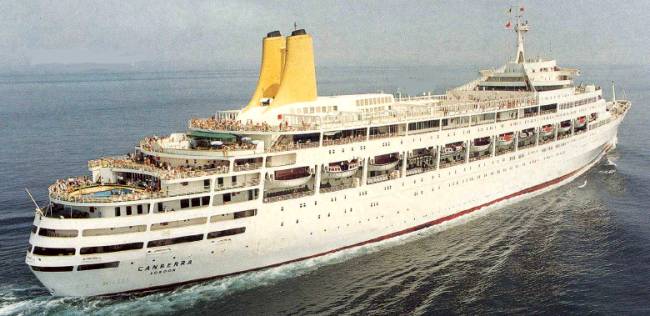
In all respects a
magnificent, innovative new ship, a worthy flagship for the P&O, she marked the
dawning of a new era in ocean travel......
Strathaird
was sold to the Shun Fung Ironworks of Hong Kong for £382,500, and on
Saturday 24th June,
she
left Tilbury for the
last time, commanded by Captain D.
West.
On the 27th July 1961, she was formally handed over to Mr L.Y. Leung at Hong
Kong. and in November, P&O announced that her steel was being melted
down and re-rolled into reinforcing bars - to be used in the construction of new
skyscraper blocks in the colony.
In her time, she had achieved
greatness, while bringing ocean cruising to the people of Australia, and making
new friends wherever she went..........
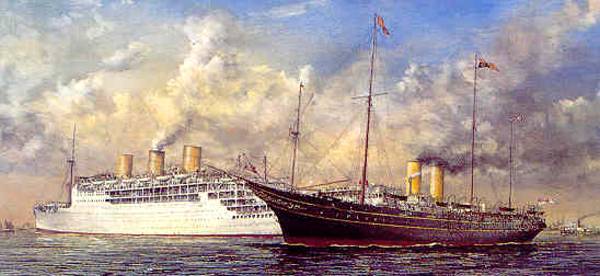
The Royal Yacht, Victoria
and Albert, passes astern of Strathaird, in the Thames, off Gravesend, Kent.
Painting: Twilight on the
Thames by Robert G.Lloyd




















































